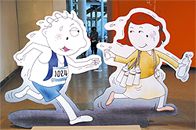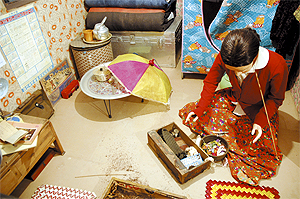She is anywehre, at any time...
SHE IS anywhere, at anytime. Through hard times, she is there to hold you. When facing temptations, she is there to stop you. She will laugh with you, cry for you, die for you with her unconditional love. Far too often though, she is easily forgotten. Her small but endless fight for you passes unnoticed in front of all the big events. How could you ever thank this nameless hero? Crying out "Oh! Mother"is a start. 
Exhibition of memories
Commemorating the 60th Korean Independence anniversary, a special exhibition, Oh! Mother, Korea is what you made happen (referred to as "Oh! Mother" here after) is being held at the War Memorial of Korea. Under the joint auspices of the Chosun Ilbo and the War Memorial, the exhibition shows the past 60 years in Korean history, focusing on the mother's place in it. Like past expositions about Kokuryo (1993), 50 years of Korea (1998) and the 6.25 war (2000), Chosun Ilbo once again presents an exhibition combining modern history and memories. To do so, a whole year of preparing and planning was spent. This carefully arranged exhibition is now open to all public.
All in one set 
Oh! Mother is a large-scale exhibition composed of several parts with different themes. First, the main historical facts of Korea since 1945 are presented on a round wall around the exhibition hall. Along with the records, are shown actual objects from the past.
The visitors are then lead to another room where charts, records and genuine female artifacts show how the social activities of women have changed since the 1940s. Their opinions on several subjects are expressed on charts, while pictures, cartoons, poems and scenes from movies depict the image of motherhood. Personal letters and items are also one of this corner's special aspects.
"The Road of Memory" is probably the liveliest corner of the exhibition. A life size set of a street from the 1960s takes the visitors to the past. One can also go up the dal-dongnae (slums that used to be main housing system until the 1970s) and see where and how people lived at that time. 
Following the set comes a wall that shows the pop culture since the 1950s. With well-known songs and movies, one can follow the flow of music and film genres. Each period of time had its own characteristics and one can identify one's own "trend".
Then comes one of the most advertised parts of the exhibition, the doll exposition by Lee Sung-eun and Heo Hun-sun. At the end of the visit, those who wish to do so can also watch a movie about the last 60 years of motherhood.
Mothers: then and now
"Mother" is a very common concept. Works of art and literature paying homage to mothers' love are countless. What makes this particular exhibition special then? One of the major aspects is that mothers are seen in the concept of history. "While most historical views focuses on facets often seen as masculine such as politics and economics, Oh! Mother sees history through the mother's point of view. It shows how our mother's strong will of life was the motive for Korea's development.", explains Lee Moon-june, Manager of the Cultural Promotion Center of Chosun Ilbo. Mothers and history are thus tied in a same knot. 
This exhibition is also about "revival". Rather than being an abstract aspect of motherhood, it recreates the mothers of the past-where they lived, what they did, what they used?with original items. "All of the actual objects shown in the exhibition have been collected through different processes. Corporations, such as LG Electronics for the first color television got involved. Personal collectors lent items, such as those used to decorate the 1960s shops. Letters and legacies from mothers were accepted through public subscriptions. The result is different items and corners all under the general theme of a facet of modern history seen through soft, heart-warming emotion and fun with memories," says Lee.
These items are thus more than plain historical records. Personal touches can be found in most of it. Heartfelt letters sent to mothers, private objects left behind create a bond between the visitors. Especially as these letters and items come from all over the country, and some are also from famous people, one realizes that mother's love has no boundaries.
The noble purpose of the exhibition -to think about our mother's sacrifice and thank them once more- can easily be felt. However, most of the visitors are adults, here to recall their pasts or show it to their young children. The generation that directly profits from the comfort our parents and grandparents strived to establish, are young people in their late teenage years and above. They are also the ones that seem most absent in the exhibition. Oh! Mother is definitely an opportunity where one could learn a lot. The fact that it is held at the War Memorial, now symbol of the past and the lack of direct attractions for young people unfortunately keeps them from participating actively.
More than a touch of history
Modern history, feminine history, pop culture history of the past 60 years. The exhibition also presents several historical aspects of Korea since the 1940s. The detailed history presentation can confuse the visitor, as some of the content does not seem related to the main theme. The corner showing women's social position, especially, focuses more on the political side than the personal feelings the exhibition tries to give overall. It presents how female power has gradually grown in our society with the "first edition of women report in 1952", or the "first woman head of police in 1993". These facts are far from the warm motherhood one expects when one sees the title of the exhibition. Also, the pop culture corner, although interesting enough, does not seem necessary when looking at the exposition as a whole.
To understand how someone lived, it is important to understand the background. Mothers, although hardly ever in front of the events, are those who cared about it the most, as it affects their family. Therefore, the main events of the past 60 years, whether historical, economical, or just a change in trends, can be relevant to the mother's life. Parts of the exhibition do not fail in giving the very situation of the past, allowing people to grasp the hardship our mothers had to go through. Because it still is history, however, it conserves the conventional history-exhibit side, affecting slightly the exhibition's uniqueness. 
Mother, you made us all.
"Women are weak, but mothers are strong". One might add to this, "especially during hard times". The past 60 years have been one of the most complicated and difficult times for Korea. Now that the gap between the tumultuous years and the relatively stable today is getting larger, one tends to forget about it. Mothers, in particular have never really received the highlights for their work. It is time to remember once again now and say, "Yes, Mothers, you made it all happen."

